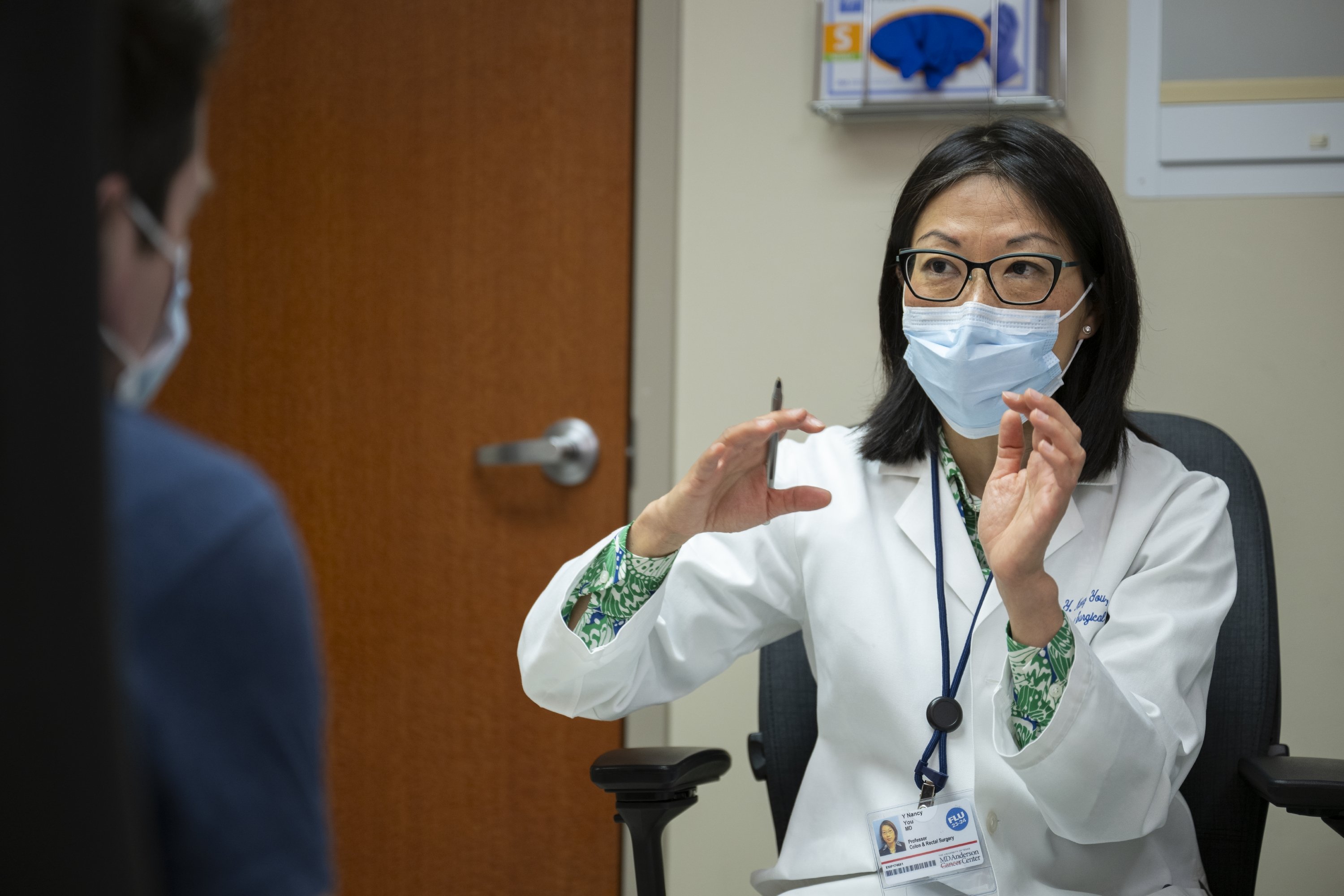- Diseases
- Acoustic Neuroma (14)
- Adrenal Gland Tumor (24)
- Anal Cancer (68)
- Anemia (2)
- Appendix Cancer (16)
- Bile Duct Cancer (26)
- Bladder Cancer (72)
- Brain Metastases (28)
- Brain Tumor (232)
- Breast Cancer (714)
- Breast Implant-Associated Anaplastic Large Cell Lymphoma (2)
- Cancer of Unknown Primary (4)
- Carcinoid Tumor (8)
- Cervical Cancer (158)
- Colon Cancer (166)
- Colorectal Cancer (116)
- Endocrine Tumor (4)
- Esophageal Cancer (44)
- Eye Cancer (36)
- Fallopian Tube Cancer (8)
- Germ Cell Tumor (4)
- Gestational Trophoblastic Disease (2)
- Head and Neck Cancer (12)
- Kidney Cancer (128)
- Leukemia (342)
- Liver Cancer (50)
- Lung Cancer (286)
- Lymphoma (278)
- Mesothelioma (14)
- Metastasis (30)
- Multiple Myeloma (100)
- Myelodysplastic Syndrome (60)
- Myeloproliferative Neoplasm (4)
- Neuroendocrine Tumors (16)
- Oral Cancer (100)
- Ovarian Cancer (172)
- Pancreatic Cancer (160)
- Parathyroid Disease (2)
- Penile Cancer (14)
- Pituitary Tumor (6)
- Prostate Cancer (146)
- Rectal Cancer (58)
- Renal Medullary Carcinoma (6)
- Salivary Gland Cancer (14)
- Sarcoma (238)
- Skin Cancer (294)
- Skull Base Tumors (56)
- Spinal Tumor (12)
- Stomach Cancer (64)
- Testicular Cancer (28)
- Throat Cancer (92)
- Thymoma (6)
- Thyroid Cancer (96)
- Tonsil Cancer (30)
- Uterine Cancer (80)
- Vaginal Cancer (16)
- Vulvar Cancer (20)
- Cancer Topic
- Adolescent and Young Adult Cancer Issues (20)
- Advance Care Planning (10)
- Biostatistics (2)
- Blood Donation (18)
- Bone Health (8)
- COVID-19 (362)
- Cancer Recurrence (120)
- Childhood Cancer Issues (120)
- Clinical Trials (630)
- Complementary Integrative Medicine (22)
- Cytogenetics (2)
- DNA Methylation (4)
- Diagnosis (232)
- Epigenetics (6)
- Fertility (62)
- Follow-up Guidelines (2)
- Health Disparities (14)
- Hereditary Cancer Syndromes (126)
- Immunology (18)
- Li-Fraumeni Syndrome (8)
- Mental Health (116)
- Molecular Diagnostics (8)
- Pain Management (62)
- Palliative Care (8)
- Pathology (10)
- Physical Therapy (18)
- Pregnancy (18)
- Prevention (912)
- Research (392)
- Second Opinion (74)
- Sexuality (16)
- Side Effects (604)
- Sleep Disorders (10)
- Stem Cell Transplantation Cellular Therapy (216)
- Support (402)
- Survivorship (320)
- Symptoms (182)
- Treatment (1786)
CT scans and cancer risk: What patients need to know
3 minute read | Published April 16, 2025
Medically Reviewed | Last reviewed by Frank Dong, Ph.D., on April 16, 2025
A computerized tomography scan, also called a CT scan, provides detailed images of your body to help doctors diagnose and treat various health conditions, including cancer. However, there have been concerns about the potential cancer risks associated with the radiation exposure from repeated scans.
Here I’ll explain how CT scans work, their important role in diagnosing and treating cancer, and how we minimize radiation exposure to keep patients safe.
How are CT scans used in cancer care?
A CT scan is a medical imaging test that combines X-rays and computer technology to create detailed cross-sectional pictures of the inside of your body. These detailed “slices” allow doctors to examine your bones, organs, blood vessels and soft tissues with much greater clarity and precision. The computer can even combine these slices to create three-dimensional models of specific areas in your body.
CT scans play a key role in various cancer stages:
- Detecting a cancer diagnosis
- Determining cancer staging
- Planning effective treatment
- Monitoring treatment progress
By providing clear and detailed images, CT scans help doctors make quick and accurate decisions in your cancer diagnosis and management.
Understanding radiation risks and reduction strategies
Our current understanding of radiation risk comes primarily from statistical analyses based on data from atomic bomb survivors, who experienced significantly higher radiation doses than those occurring during medical imaging.
Imaging tests like X-rays and CT scans use low levels of radiation to help doctors see inside your body. CT scans provide more detailed images than standard X-rays, which is why they require slightly higher radiation doses. It is important to note that there is no direct evidence of any person getting cancer from a CT scan.
MD Anderson uses some of the most advanced equipment available to perform CT scans. This provides better image quality at a significantly lower radiation dose. Our imaging physicists also continually optimize the CT protocol and can offer a low-dose protocol for some younger patients. In addition, we monitor, test and calibrate every CT scanner to assure its performance and safe use. We adhere to the highest standards of quality and radiation dose management as defined by accreditation and regulatory bodies.
Our providers follow rigorous protocols to ensure CT scans are performed only when medically necessary. We also customize radiation doses based on each patient’s physical characteristics and the specific purpose of the scan. This maintains our commitment to both diagnostic accuracy and patient safety.
Balancing the benefits and risks of CT scans
While CT scans are incredibly helpful for diagnosing and treating cancer, they should be performed only when the information that may be gained could be beneficial to the patient’s care.
If you have concerns about radiation exposure, don’t hesitate to discuss them with your health care provider or radiologist. Some questions you may ask are: “How will this scan help guide my treatment?” or “Are there alternative tests that don't use radiation that might work instead?” They can explain the reasons for the test and how they ensure your safety.
You should feel safe having a requested CT scan. The small risk of receiving a CT scan is typically outweighed by the substantial benefits of accurate cancer diagnosis and treatment.
Frank Dong, Ph.D., is a clinical medical physicist.
Request an appointment at MD Anderson online or call 1-866-915-2377.
Related Cancerwise Stories

You should feel safe having a requested CT scan.
Frank Dong, Ph.D.
Researcher





